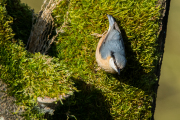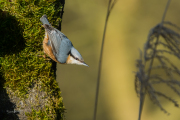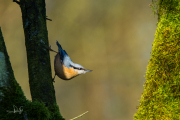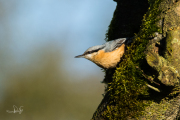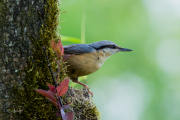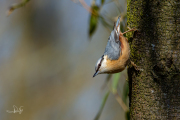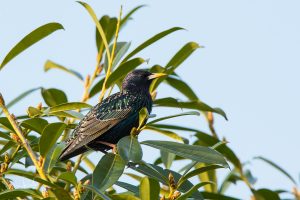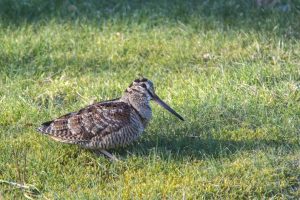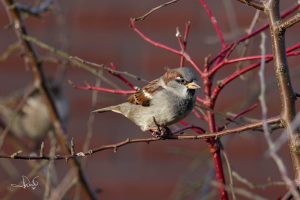Recently new residents have moved into our garden. Flying residents to be more specific. It has always been busy in our garden, especially in the winter months on the bird feeders, but since last winter we have a new visitor. It started with one bird, but after a while a second came. It’s a bird that is also fairly new to our village. In the past, I once saw one coming out of an old starling nest in a tree, but after that I never saw or heard one again. I’m talking about the Eurasian nuthatch (Sitta europaea), a beautiful bird with a blue-gray back and a rusty brown belly.
Up and down against the tree
A true virtuoso when it comes up to climbing or descending trees. Because that’s what a nuthatch does. The little bird walks just as easily with its head down along the trunk and then crawls up again with the head raised. Continuously looking for bugs that have hidden behind or in the tree bark. But also seeds and nuts are on its menu. The bird places them in the bark of the tree and break them with its beak. Or it simply holds the nuts with one claw to break them. A mistake is quickly made by non-birdwatchers with a tree creeper (Certhia brachydactyla). Apart from the colour there is another important difference: the tree creeper can only crawl upwards.
Onomatopoeia
According to etymologists (the scientists who study the origin of words and in this case bird names), the scientific genus name of the nuthatch Sitta comes from the sound the bird produces, an onomatopoeia. (I really love that word! The name cuckoo and chiffchaff are also onomatopoeias. We give some birds their name based on the sound they make.) The ancient Greeks named a certain bird Sitte for “one that provides for its maintenance by pecking on wood”. But it is not clear whether they meant the nuthatch or a woodpecker. In view of the sound that the nuthatch can make, it is more likely to the this bird.
Mason
Nuthatches make their nests in cavities. Often in old woodpecker nests or natural cavities in for example beeches (Fagus sylvatica). But they also use nest boxes. Not only the ones with a small opening, meant for tits and tree sparrows, but also those with very large openings for birds such as tawny owl. Those nest box has an opening of up to 15 centimeters. Nuthatches use mud/clay to reduce the size of the flight hole to only about three centimeters.Like a little mason. Just small enough to crawl through.
This way it prevents predators, such as the great spotted woodpecker (Dendrocopus major) and jay (Garrulus glandarius), from snatching away its youngsters. That doesn’t always work. When a hungry woodpecker has its eyes set on the young birds, it will not stop to try to remove the grout and get access to the nest.
To my great joy the nuthatch remained interested in the nest box in our garden. And when a great spotted woodpecker showed up and came too close, it was immediately attacked by a very fierce nuthatch, which chased the woodpecker out of the garden.
Eight youngsters
At one moment it was very clear that the nuthatches had chosen our nest box to breed in. Nesting material was dragged in. Nuthatches don’t line their nest with moss, hair and feathers, like tits do, but they lay bark particles and dead leaves on the bottom. The female lays six to nine eggs, which will hatch after about two weeks of breeding. At one point I saw the nuthatches fly away with food and a squeaky sound came out of the box. So the chicks had hatched! After that, the youngsters were fed for another 24 days. The parent birds were very busy with feeding, which allowed me to film them. In this footage you can see the parent birds flying with food (flies, spiders, mosquitoes and other insects) and sometimes coming out of the nest box with a sort of little white bag. That is the youngster’s shit, which is neatly packaged in a membrane and removed from the nest by the parents. This keeps the nest clean. There are more birds that keep their nest clean in this way.
Rings
At one point my friend Rinus Dillerop came around for a cup of coffee and we decided to ring the youngsters. Rinus is a very experienced bird-ringer with many years of experienceand also has a licence to do this in our area. Carefully he opened the nest box and there were eight young birds waiting for what would come. The small and delicate creatures looked healthy and had a nice weight of around 22 grams. There was one outlier with a weight of 14 grams, but that one also looked healthy. Skillfully Rinus fitted all the youngsters with a ring around their leg, so they will go through life as number V575685 up to and including V575692. This way we have the possibility to follow how the population of nuthatches may expand further. The parents will stay in the neighbourhood, because nuthatches are very homonymous and perhaps some of their offspring will also settle in our village.
Fledging
Based on an estimate of the starting moment of the feeding and the size of the youngsters, Rinus and I expected that the young birds would remain in the nest for about a week. Eventually they fledged a week and a half later. Although I had prepared the camera to film that beautiful moment, unfortunately it didn’t work out that way. I came back from walking our dog one evening and heard some fledglings in the prunus in which the nest box hangs. So they already fledged! But I also heard one in the nest box, probably the outlier. I was curious to see whether the parents would not forget this little one. After all, they continue to feed the fledglings for a few days. But luckily one of the parents came to the nest box after some time. The next morning this last chick also fledged. The nuthatch population in our village has therefore increased by eight. And who knows, maybe there will be a second brood.
Sources:
This post was originally published in Dutch on May 27th 2018



